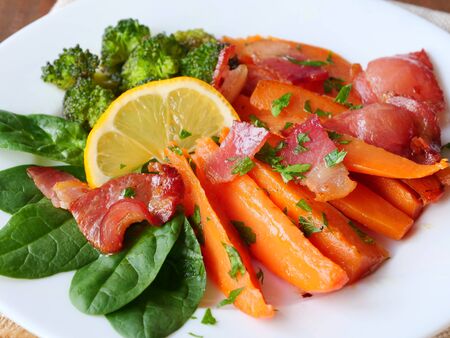
Bacon Bits Nutrition: A Detailed Look at the Nutritional Profile of This Popular Snack
Bacon bits, those tiny, crispy pieces of bacon, have become a staple in many recipes, from salads to baked potatoes. But what exactly is in them, and how do they fit into your diet? Let’s dive into the nutritional details of bacon bits to help you make informed choices.
Caloric Content

One of the first things to consider when looking at the nutrition of bacon bits is their caloric content. According to the United States Department of Agriculture (USDA), a tablespoon of bacon bits contains approximately 45 calories. This might not seem like much, but when you’re using them in larger quantities, the calories can add up quickly.
Fat Content

Bacon bits are high in fat, which is not surprising given that they are made from bacon. A tablespoon of bacon bits contains about 4.5 grams of total fat, with 1.5 grams being saturated fat. This is important to keep in mind if you’re watching your fat intake, especially saturated fat, which has been linked to heart disease.
Protein and Carbohydrates

Despite their high fat content, bacon bits do provide some protein and carbohydrates. A tablespoon contains about 1.5 grams of protein and 0.5 grams of carbohydrates. This makes them a decent source of protein for those looking to increase their intake, although the carbohydrates are minimal.
Sodium and Cholesterol
One of the most concerning aspects of bacon bits is their sodium and cholesterol content. A tablespoon of bacon bits contains about 150 milligrams of sodium and 5 milligrams of cholesterol. This can be problematic for individuals with high blood pressure or those who are watching their cholesterol levels.
Other Nutrients
While bacon bits are not a rich source of vitamins and minerals, they do contain small amounts of certain nutrients. For example, they contain small amounts of niacin, vitamin B6, and selenium. However, these nutrients are not significant enough to make bacon bits a health food.
How to Use Bacon Bits
Now that you know the nutritional details of bacon bits, you might be wondering how to use them in your cooking. Here are a few ideas:
- Add them to salads for a crunchy texture and smoky flavor.
- Top baked potatoes with bacon bits for a savory crunch.
- Use them as a topping for pizza or burgers.
Alternatives to Bacon Bits
For those looking to reduce their intake of bacon bits or avoid them altogether, there are several alternatives:
- Use a sprinkle of nutritional yeast for a cheesy, savory flavor.
- Try a sprinkle of dried herbs and spices for a flavor boost.
- Use a small amount of crumbled cooked bacon for a similar texture and flavor.
Conclusion
Bacon bits are a tasty addition to many recipes, but their high fat, sodium, and cholesterol content make them a treat rather than a health food. By understanding their nutritional profile, you can make informed choices about how often and in what quantities to use them in your cooking.
| Nutrient | Amount per tablespoon |
|---|---|
| Calories | 45 |
| Total Fat | 4.5g |
| Saturated Fat | 1.5g |
| Protein | 1.5g |
| Carbohydrates | 0.5g |
| Sodium | 150mg |
| Cholesterol | 5mg |





